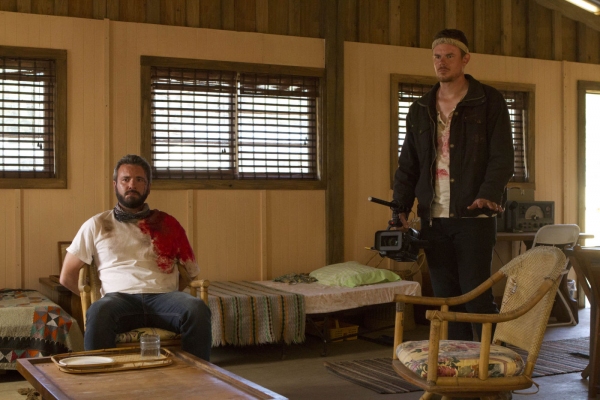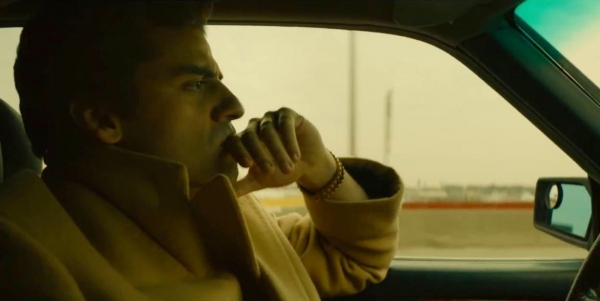11 Offenses of 2014
Here we go again. All things considered, 2014 wasn’t a banner year in terms of cinematic offense. Recent years were teeming with truly hurtful five-letter words, but the past twelve months provided us no Shame to soil our souls, no Drive to melt our eyeballs, no Babel to bore us silly, no Crash to slowly kill our brain cells. Even so, there were a handful of stinkers that got under our nostrils, and it has been really tough to eradicate the sense-memory of the ones that really made us wince. From award-trolling pabulum to multiplex garbage to films by directors we once praised, these were movies that made our beloved medium seem like the seventh art we’d ever spend time considering at all.
[Capsules by Julien Allen, Ashley Clark, David Ehrlich, Michael Koresky, Adam Nayman, Nick Pinkerton, Jeff Reichert, Andrew Tracy, Genevieve Yue, and Farihah Zaman.]
The Imitation Game
The story of Alan Turing probably cannot be sufficiently made into a movie. This might seem an odd statement since the extraordinary facts of his life—he was a brilliant mathematician and groundbreaking computer scientist who cracked the Nazi code, thus helping the Allies defeat Germany in World War II—seem tailor-made for a rip-snorting 122 to 135 minutes of backroom handwringing. If only there were not more to his tale: in the early fifties, a period in British history particularly marked by draconian witch-hunting against men suspected of “indecent acts,” the gay Turing was arrested by the police before electing to be chemically castrated rather than serve prison time. Two years later, he committed suicide by cyanide poisoning. His story is so unbelievably horrifying and unjust that to make a glossy, largely feel-good bit of craven, Masterpiece Theater–ready awards bait like The Imitation Game out of it feels downright dastardly. After a couple hours of the most standard British wartime melodramatics and eye-glazing visual dullness (peep that match-cut from an underwater torpedo being fired to—BAM!—a pencil moving into a sharpener . . . cinema!), Turing’s tragedy is treated as a last-act nuisance, like a few final crumbs brushed from an otherwise shiny lapel. By positioning Turing (Benedict Cumberbatch) as an interpersonally challenged scientist weirdo, more stuttering machine than suffering man, the film conveniently excuses itself from turning him into a sexual being (his only significant human connection onscreen is his chaste bond with an adorable and improbably gay-OK fellow code-breaker played by Keira Knightley). In doing this, the film not only pushes this mistreated historical figure back into the celluloid closet, it dramaturgically shoots itself in the foot: at the abrupt climax, Turing’s ghastly punishment barely registers since, throughout The Imitation Game, he’s already been neutered. —MK

St. Vincent
I grew tired of Bill Murray’s “comeback” around the time of 2005’s Broken Flowers, which duly followed the path of least resistance laid by Rushmore and Lost in Translation: just cast the great man as an effigy for midlife malaise and let his elegantly hangdog presence do all the heavy lifting. In 2004, after the release of The Life Aquatic With Steve Zissou, Kent Jones observed in Cinema Scope that Murray, though one of “the cinema’s greatest counterpunchers,” was ill-suited to leading roles with redemptive arcs; a decade later, St. Vincent offers definitive proof. The film was hyped to the skies both at and by the Toronto International Film Festival, who declared its premiere a makeshift civic holiday in Murray’s honor, and it shamelessly milks its star’s irascible hipster persona while adding a few serious-actorly wrinkles. Its eponymous, forlorn suburban grump, who gets a new lease on life when he’s befriended by a lonely, nerdy little boy next door, cries, gets falling-down drunk, and suffers and recovers from a stroke. (And for the latter, as Team America reminds us, you gotta have a montage.) Make no mistake: all of this seriocomic mishegas is for posterity’s—and its good pal Oscar’s—sake. First-time director Theodore Melfi is neither talented nor ethical enough to even try to disguise these award-trolling intentions, and the desperately dirty dialogue and conscientiously indie soundtrack (enjoy your walk-in humidor, Matt Berninger) are telltale signs of a wannabe-cool crowd-pleaser. The sad thing is that at this point, that’s an apt descriptor of Saint Bill himself. —AN

The Sacrament
How long it takes you to accept that not one remotely scary or genuinely inventive idea is going to emerge from this film’s 95-minute running time may depend on how many collywobbles Ti West’s two previous, cleverly wrought shockers, The House of the Devil and The Innkeepers, gave you in the first place. To the Ti West faithful, even the baffling predictability of the setup (a documentary crew penetrate a remote utopian community and find that all is not as it seems; the images we see are those they captured with their cameras) might lead us to anticipate a new twist on the found-footage subgenre. Nope. As the clichés start raining down—“Hmm, these people don’t really seem all that happy”; “Whoa, a creepy, blonde child startled me!”; “Hey, let’s run and scream stuff like ‘Oh, God, no!’ while filming at the same time!”—at best you'll be tempted to repress your disappointment, sit back and just let it wash over you as an innocuous horror knock-off. But you don’t get away that easily, for a well-realized sequence at the halfway mark in which the sinister “Father” (Gene Jones) preaches to his flock, foreshadows the film’s questionable ambition. It becomes horribly clear that Ti West is doing his barely reimagined version of the 1978 Jonestown massacre. Then it dawns that he’s actually going to show all those harmless deluded families drinking the Kool-Aid and dying in agony for no good reason. Welcome to the most tastelessly pointless and pointlessly tasteless fifteen or so minutes of cinema in 2014. In the wake of the likes of Wolf Creek, The Sacrament is doing its bit to liberate atrocity porn from the ghetto of heart-tugging true-life drama films and haul it into the realm of pure exploitation, all with a catastrophically straight face. Oh, and by the way, the fictional crew left the second camera in the camp when they fled for their lives at the end, so half the footage we saw wouldn’t have been possible. Come to think of it, if only the filmmakers had done the same, we might have been spared this meretricious trash. —JA

Jimi: All Is by My Side
It’s safe to say that 2014 will not go down as a banner year for biopics of great African-American musicians. Cynthia Mort’s controversial, long-delayed Nina Simone film found itself marooned in a legal mire, while Tate Taylor’s irritatingly overcranked Get On Up swiftly vanished up its own zany backside, in the process neglecting entirely to address James Brown’s crucial relationship with his black audiences. John Ridley’s risibly undercooked Jimi: All Is by My Side—a fictionalized chronicle of Jimi Hendrix's pre-fame London year in the mid-1960s—was even worse. The Hendrix estate wisely refused Ridley the use of the guitar hero’s music, so the sounds to which we are treated—aimless, wanky noodling (sadly appropriate)—are fused with cringe-worthy, pseudo-1960s avant garde editing in a doomed attempt to foster a sense of place. On this front, Ridley consistently proves himself to be below standard: his idea of conjuring a feel for the era manifests in remedial-level exposition, clanging place-markers (I can't recall ever seeing the red London bus as overused as it is here), and incessantly gauche namedropping. OutKast alum André Benjamin, meanwhile, incarnates Hendrix as a vaporous, shambling savant, spitting out oblique aphorisms in a barely decipherable, tommy gun–like mutter. Benjamin’s impersonation isn’t terrible, but it’s a corrosively one-dimensional trick, and the characterization of Hendrix in Ridley’s script is so vague that it’s impossible to discern whether he is trying to demystify or further mythologize the man. A sour postscript revealed a crime of an even more heinous nature: Hendrix’s ex-girlfriend Kathy Etchingham railed against the film’s fabricated portrayal of his physical abuse of her. It’s bad enough to make a singularly uninteresting, uninsightful film about an enigmatic musical legend; another thing entirely to falsely finger him as a woman-beater. —AC

Gone Girl
David Fincher’s winkingly nasty adaptation of Gillian Flynn’s postgrad-clever potboiler has already attracted reams of commentary, and acquired passionate and eloquent defenders and detractors both, so one more screed against it hardly seems necessary at this point. For this detractor, though, the overwhelming feeling is one of rueful regret that so much passion and eloquence was squandered on an object so unworthy. The crux of the matter—is it a scathing satire of misogyny, or just plain misogynist?—is made moot by the fact that the film itself doesn’t care either way. While it’s true that Rosamund Pike’s ivory-skinned spider woman is ultimately not treated as anything more than a cartoonified femme fatale, Gone Girl: The Movie never truly departs the default plane of movie-world “realism”; it has neither the hyperbolic exaggeration nor the wry distance required for actual satire, never mind Fincher’s typically cool remove. What it does have is hefty doses of glib, po-po-mo nattering about the Masks We Wear and the Personas We Adopt—catnip for a cultural climate that defines art (and, increasingly, reality) as primarily a matter of positioning and branding. Perhaps this is why the is-it-or-isn’t-it debate ultimately feels so futile. Gone Girl isn’t a provocation, it’s playing the part of a provocation, and all the while smugly congratulating itself on its ability to commit to nothing except its own immaculate, frictionless surface. —AT

Finding Vivian Maier
What could possibly be wrong with Finding Vivian Maier, the critically lauded, Academy Award–shortlisted documentary about a nanny with a camera and a dark side, whose treasure trove of street photography negatives was discovered only posthumously? It is true that Maier’s photographs are stunning and her story, that of a deeply troubled hoarder driven to make art but unable to share it, is fascinating, instigating questions about who gets to make art, and who gets to anoint it as such. The issue is director John Maloof’s forced insertion of himself into the tale. The framing story is how he, John, found the photographs, brought them to the world, and taught us how to love them. When Maier’s story begins, it is difficult not to wonder why so much time was spent looking at blurry images of garage doors and Google searches, listening to some tool mansplain what made Maier’s work so great rather than letting the art speak for itself. Most egregiously, Maloof literally will not let Maier speak for herself, mentioning at one point that she made several audio recordings which were included in the lots he purchased, then infuriatingly refusing to play excerpts from any of them, depriving the world of this potential window into the innermost workings of a notoriously private and mysterious artist. Maloof’s unnecessary centralization of himself in the film also brings up an ethical concern that only a handful of critics delved into (most notably Manohla Dargis in the New York Times), which is that Maloof owns the rights to the photographs and therefore has a huge amount to gain by making a case for Maier and the mythology of his sleuthing. This is a subject-mistaken-for-filmmaking situation in which Maloof’s questionable choices are overlooked, his smug, self-serving introduction and narrative framework all but forgotten because the complex beauty of Maier’s life and work graciously overshadow them. —FZ

A Most Violent Year
To give J. C. Chandor credit, he’s a much cannier businessman than Abel Morales, the fuel oil salesman played by Oscar Isaac who is at the center of Chandor’s third feature, A Most Violent Year, and who makes up in ambition what he lacks in peripheral awareness. After doing quick-draw ripped-from-the-headlines with 2011’s Margin Call, Chandor took anointed legend and Sundance capo Robert Redford on a yachting holiday in 2013’s All Is Lost, shunned by audiences but an industry-insider goodwill-generating succès d’estime that set its author up for a grab at the brass ring, which comes with his A Most Violent Year. Chandor’s method is to collect proven quantities, which someone else has already taken a risk on, including his stars, Isaac and Jessica Chastain, and his aesthetic, a New York City grisaille cribbed from James Gray and Sidney Lumet. He handles his story, a save-the-family-business fundraising countdown à la Tommy Boy, with the conscientious care of someone in an egg-and-spoon race, which assures that no point will be less than laboriously elucidated, and safely arrives at the conclusion that all movies about the business world must inevitably arrive at: that anyone working in it must be a morally numb sociopath, which, even if true, can’t really bear ad nauseam repetition. Chastain’s iron lady mercy-killing of a wounded deer and Isaac absentmindedly stepping over the corpse of a employee who’s just killed himself to plug up a leaking fuel tank compete for the most overdetermined gestures of the year. The last is Chandor’s attempt at a Michael Corleone’s-weary-ascension moment, though he’d do better to stick to ring-kissing himself. —NP

The Hunger Games: Mockingjay—Part 1
What sensationalized the first two Hunger Games movies were the games themselves. The sight of teenagers murdering each other—or fending off killer monkeys—was, if nothing else, entertaining. This works thematically, too: the games are meant to distract the populace of the futuristic world of Panem from its miserable, slave-like existence under the brutal dictatorship of the metropolitan Capitol. The Hunger Games: Mockingjay—Part 1, however, dispenses with the central spectacle that made the previous films watchable. In this bloated half-conclusion to the series (we have Harry Potter to thank for making movie adaptations longer than their literary sources), we’re left to suffer through the flimsy, implausible politics the other films managed to avoid. Panem, it turns out, makes no sense. The Capitol boasts the height of technological advances, including monorails and an elaborate virtual gladiatorial stadium, but Katniss Everdeen (Jennifer Lawrence), who lives in an impoverished coal-mining region, must still churn her own butter like a nineteenth century frontierswoman. Raw materials excavated or produced in each of the supplier districts are somehow transformed into cosmetics and wigs for Capitol citizens. Faced with such cartoonish injustice, the people are understandably ready to revolt, but the leaders of the revolution can barely articulate what they’re fighting for. Instead, Mockingjay focuses on a similarly inchoate Katniss, who, for all her Hunger Games victories (here she fires a single arrow), spends most of the film watching things. It’s as dull as it sounds: she surveys the wreckage of a District 12 uprising, visits a hospital that’s immediately bombed, sings a little ditty by a lake, and talks to a TV that shows Peeta (Josh Hutcherson), her sometimes boyfriend who’s being held hostage in the Capitol. The people of Panem rally to her image as the “Mockingjay,” the face of the revolution, because half-baked plans in this world always succeed. But the action, dimly promising as it is, happens later. This turgid middle chapter, meanwhile, offers little more than a series of Katniss’s slack-jawed reaction GIFs. —GY

This Is Where I Leave You
Riddle me this: since his role on the beloved-by-many Arrested Development over a decade ago, has Jason Bateman starred in a single damn film worth watching? If anything, the appearance of his scrubbed-clean hangdog everydude in a movie trailer is as sure a sign to head for the hills as a card reading “A Film by Tom Shadyac.” Bateman’s continued laziness as an actor, his total inability (or unwillingness) to widen his well-established, hemmed-in range, is on full display in the rank contraption that is This Is Where I Leave You, and is indicative of the film’s most glaring problem—it’s just as putridly indolent as he is. And this, in turn, reveals that the movie commits among the worst sins possible toward its audience: condescension. If the filmmakers clearly didn’t show up, why should we? This “dramedy” about a bunch of estranged siblings forced to sit shiva in the wake of their father’s death by their overbearing, boob-enhanced mother (Jane Fonda, having some kind of time), plumbs no dime-store psychological depths you wouldn’t expect, employs every possible family-movie cliché, and even manages to botch its one novel idea (a late-in-life polyamorous relationship brought about by shared illness and tragedy) by framing its revelation as the narrative equivalent of a fart gag. Yes, by now we all know to expect meager return on any time invested in this brand of droll, Hollywood-ized “life sure is funny and sad all at once, right?” experience, but even by those standards, This Is Where I Leave You is truly the pits. Bonus hate for dragging Tina Fey, who herself is teetering on the brink of Bateman-ing her movie career, down with the ship. —JR

Neighbors
One published critic described Nicholas Stoller’s Neighbors as “smart, silly, and sweet”; another lauded its characters’ “surprising amount of depth”; and still another dubbed it not only “exceptional” but also “a successful attempt to reinvent the studio comedy.” Never do I feel more like Rip Van Winkle than when watching well-received contemporary mainstream American comedies such as these; did I fall asleep and wake up in some disturbing future mediocracy in which “smart, silly, and sweet” is journalist code for “dumb, heavy-handed, and nasty”; “surprising amount of depth” translates as “expectedly, depressingly shallow”; and “a successful attempt to reinvent the studio comedy” actually means “a successful endeavor to ensure that no one in the audience is ever challenged and that everyone goes home feeling terrible about themselves as thinking, feeling human beings”? Neighbors, a film about a nice couple getting into an increasingly mean-spirited, violent battle with their frat-house foes next door, is as simplistic as its title (with this, Stepbrothers, Bridesmaids, and this year’s Sisters, with Tina Fey and Amy Poehler, we seem to have entered the “no need for actual titles” phase of movie culture—how long until we have a movie just called Penises?). Seth Rogen does his usual teddy bear with a temper routine, and as his wife Rose Byrne again proves her comic chops even though she’s woefully under-used; but it’s Zac Efron, with his creepy abs and ersatz, low-decibel man grunt (see also That Awkward Moment, but, really, don’t) who truly makes this a tough sit. We’ve officially reached the stage where homophobic jokes are supposed to be not homophobic at all simply because the filmmakers are self-aware when making them, but that doesn’t let Neighbors off the hook in my book. The packed audience I saw it with roared at every intimation of ooey-gooey homoeroticism, one of which seemed to fly at us about every thirty seconds. Disguised as a takedown of bros-before-hos frat life, Neighbors is just another reaffirmation of that mentality’s depressing centrality in our culture. —MK

Cake
Daniel Barnz’s Cake represents the nadir of recent screenplays that think they’re sharp just because they’re filled with pricks. Voided from the cancerous bowels of The Black List and pumped full of money until it matured from being a story of suffering to being a vehicle for it, Cake concerns the struggles of a bullying and bitterly sarcastic rich lady named Claire Simmons (Jennifer Aniston), whose mysterious facial scars are the film’s only dramatic question. Introduced during an agonizingly self-satisfied scene in which she mocks the other members of her support group, Claire spends the brunt of the film submitting the rest of the world to her misery, her noxious misadventures cohering into a masterful illustration of how subversiveness can rot into smarm without the proper wit to fertilize it. The fact that Claire is enduring the loss of a child is almost immediately obvious, but at some point along the way Cake decides to handle this most heartbreakingly common of tragedies like it’s the secret of Shutter Island. By the time the truth is finally exposed, Cake has reduced the grieving process into the stuff of a banal mystery, i.e. something that can be solved. While Aniston acquits herself fine in the role, her fame suddenly insinuates itself into the text of the film. As soon as you deduce Claire’s revelation, the contrast between the actress’ unvarnished appearance and the public image it’s pointedly playing against begins to feel so exploitative and artificial that her character’s grief is reduced to a cheap costume. —DE
